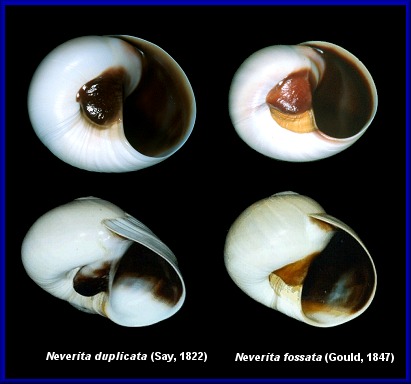| A New-Old Neverita Species From West Florida |
| By Phil Poland |
| A big, common and shallow-water species from
Florida that's new? Impossible? Some of us believe it. For years,
a number of Florida shellers have had questions about the forms
that the Atlantic Moon Snail, Neverita
duplicata (Say, 1822), seemed to take.
Conventional wisdom, as gleaned from the usual references, was that diet affected callus color, and that spire height was variable. Some of these features, but not all, seemed to come in sets. Additionally, habitat differences caught my attention. Several years ago, I revisited about 40 lots I'd collected in Florida and Georgia. I was struck by one consistent feature, and segregated the shells accordingly. Nearly all of my specimens from the west coast of Florida had strikingly different umbilici. A typical Gulf Coast shell had what I described as an umbilicus with an excavated, or gouged-out, periphery. This channel was accentuated by a thick golden-brown periostracum. No Atlantic specimen had this feature. These shells were typically globose, somewhat brownish in color, and smaller than the flattish, gray forms. Not all Gulf specimens were of the globose form with the distinctive umbilicus. In some inlet areas, and offshore, a large, gray, flattened form with a smooth and evenly rounded umbilical surface had been found. I'd seen this form dredged off both coasts in deeper water. I also had a number of these collected during very low tides on the east coast. I checked my fossil references (Olsson and Harbison, Petuch et al.) for figures or descriptions of the two umbilical forms and had no luck. In the end, with our own Harry Lee and Bill Frank, we got the two forms up in lights, on the Jacksonville Shell Club Home Page. Harry scanned my photos, and Bill built a beautiful site for them. I then prodded and whined on the Conchologists of America Listserver (Conch-L), the best Internet discussion group related to shells. Within a week, after some vigorous research and discussion by some of malacology's best, a name was found and an offer to do molecular taxonomy analyses on the forms was made. Funding for the project was provided by the Jacksonville and St. Petersburg Clubs shortly thereafter. Things never moved so quickly before. An information revolution is truly under way. Dr. Gary Rosenberg of the Academy of Natural Sciences in Philadelphia examined specimens there and concluded that a distinct form does indeed live on our Gulf coast. Dr. Rosenberg also found a description by Gould in 1847 that left little doubt as to what shell was involved. Gould stated: "This would not at first sight be distinguished from N. duplicata Say, which it greatly resembles in form and coloring, but the umbilical region is entirely different; and the deep, wide channel leading to the umbilicus bordered by an acute ridge, and covered by a spirally striated epidermis is in striking contrast with the pale polished region adjacent. " The type locality is "Florida." The name of our snail is Neverita fossata (Gould, 1847). How about a vernacular name of Gould's Atlantic Moon Snail? The standard form, Neverita duplicata (Say, 1822), could thus be Say's Atlantic Moon Snail. Also involved in the discussion was a Dr. Michael Hollmann of Goettingen, Germany, a naticid collector with strong research skills. He succeeded in finding an 1843 figure predating Gould's description. Dr. Rosenberg believes a lectotype designation is necessary before this named figure gets priority and causes our new snail to carry the name Neverita delessertiana (Récluz in Chenu, 1843). I want to thank both shell clubs for unhesitatingly funding research on these snails. Supporting research and the dissemination of information related to our special area of interest is about the best use of club resources I can imagine. Addendum - See: http://www.mapress.com/zootaxa/2006f/zt01257p025.pdf |
 Some of the shells were high-spired. The
callus (the shelly projections partly covering the umbilici on
the undersides of the shells) varied in color and shape. Some of
the shells were battleship gray, others were brownish.
Some of the shells were high-spired. The
callus (the shelly projections partly covering the umbilici on
the undersides of the shells) varied in color and shape. Some of
the shells were battleship gray, others were brownish.